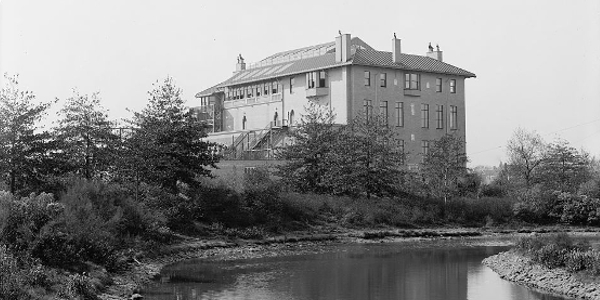
President Bush with Gulf War troops. Courtesy National Archives. Right: New York Stock Exchange in 1921 by Irving Underhill, Courtesy Library of Congress.
Sponsor this page for $100 per year. Your banner or text ad can fill the space above.
Click here to Sponsor the page and how to reserve your ad.
-
Timeline
1990 - Detail
March 18, 1990 - The largest art theft in U.S. history occurs in Boston, Massachusetts, when two thieves posing as policemen abscond more than one dozen works of art worth an estimated $100-200 million from the Isabella Stewart Gardner Museum.

What Did They Steal?
Storm on the Sea of Galilee (1633) - Rembrandt van Rijn
A Lady and Gentleman in Black (1633) - Rembrandt van Rijn
Self Portrait (1634), an etching on paper; - Rembrandt van Rijn
The Concert (1658-1660) - Jan Vermeer
Landscape with an Obelisk (1638) - Govaert Flinck
Chinese vase or Ku
Five works on paper - Edgar Degas
A finial from the top of a pole support for a Napoleonic silk flag
Chez Tortoni (1878-1880) - Edouard Manet
The theft began in the early morning hours when two thieves, dressed as Boston police officers, stated to the guard on duty at the front desk that they were responding to a call. After binding the two guards on duty, they roamed the Isabella Stewart Gardner Museum for eighty-one minutes, and stole thirteen, almost priceless, works of art (eleven paintings and etchings, one finial, and one vase). Today, the value of the works would approach $500 million. One of the oddities of the case is that the thieves, while stealing very valuable pieces, passed by others of equal or greater value.
The art has still not been recovered or the thieves caught. There is a $5 million dollar reward offered by the museum. The theft still remains the largest private property crime in United States history. While the investigation into the stolen art has led to a trail to Connecticut and south to Philadelphia, it has not been recovered and the thieves are still at large.
Several years ago, authorities seemed convinced that there was solid knowledge to the perpetrators, but, as of 2020, those have not materialized.
Details of the Case
Perpetrators waited outside the museum in a red hatchback according to eye witnesses during the night after St. Patrick's Day. They were two white males. After the breakin when the actual police responded to the robberies, they discovered additional valuable paintings and art work had been left behind, however, the thieves had also left almost no clues. Adding to the dilemma for the museum was the fact that they had no insurance for the paintings lost. Today, the frames for the stolen work hang empty in the galleries of the Isabella Stewart Gardner Museum.
The Venetian style building which houses the Isabella Stewart Gardner Art Museum was completed in 1903 and opened on January 1, 1903 as a museum. Her collection began in 1891 and continued one year later with the first major acquisition, the Concert by Johannes Vermeer (Jan Vermeer) painted in 1664, one of the pieces stolen in 1990.

What Did They Steal?
Storm on the Sea of Galilee (1633) - Rembrandt van Rijn
A Lady and Gentleman in Black (1633) - Rembrandt van Rijn
Self Portrait (1634), an etching on paper; - Rembrandt van Rijn
The Concert (1658-1660) - Jan Vermeer
Landscape with an Obelisk (1638) - Govaert Flinck
Chinese vase or Ku
Five works on paper - Edgar Degas
A finial from the top of a pole support for a Napoleonic silk flag
Chez Tortoni (1878-1880) - Edouard Manet
Other Notorious Art Thefts in History
Art theft is big business and the cases hard to solve. Only ten percent of arts thefts are recovered. Here are some of the most notorious, some recovered, some not.
Mona Lisa - On August 21, 1911, the famous painting was stolen from the Louvre by employee Vincenzo Peruggia. The museum closed of one week for investigation. Implicated were French poet Guillaume Apollinaire and his friend Pablo Picasso. Peruggia was caught in 1914 when he attempted to sell it to an Italian art dealer, Giovanni Poggi, of the Uffizi Gallery in Florence. Why did Peruggia do it; he always though the painting should hang in an Italian gallery. He served six months in prison and was hailed a patriot in Italy.
Panels from the Ghent Altarpiece - Two panels of the work by Jan and Hubert Van Eyck were stolen in 1934 by thief Arséne Goedertier, who asked for ransom. One was recovered shortly after the theft; the other never recovered as the thief died prior to giving up its location.
Nazi Plunder - The Reichsleiter Rosenberg Institute for the Occupied Territories was in charge of stealing 650,000 works of art from varoius museum in the territories they occupied; Hermann Goring was in charge of the pieces. Some of the art work was destroyed, others exhibited, and around one hundred thousand of the pieces never recovered. Examples of some of the most famous works stolen; the Ghent Altarpiece, Portrait of a Young Man by Raphael, the Astronomer by Vermeer, Madonna of Bruges by Michelangelo, and Portait on the Road to Tarascon by Van Gogh. The Ghent Alterpiece has been stolen six times, the first in 1432.
Photo above: Montage of three of the art pieces stolen in the heist: The Concert by Vermeer and Rembrandt's Storm in the Sea of Galilee and A Lady and Gentleman in Black. Below: Gardner Palace, 1904, Detroit Publishing Company. Courtesy Library of Congress. Source: Wikipedia Commons; Isabella Stewart Gardner Museum; "Inside the $500 million dollar art heist from Boston's Isabella Stewart Gardner Museum that still hasn't been solved 30 years on," 2020, James Pasley, Business Insider; theculturetrip.com; "Biggest Art Heists in History," 2022, Irina Diana Calu, dailyartmagazine.com.






